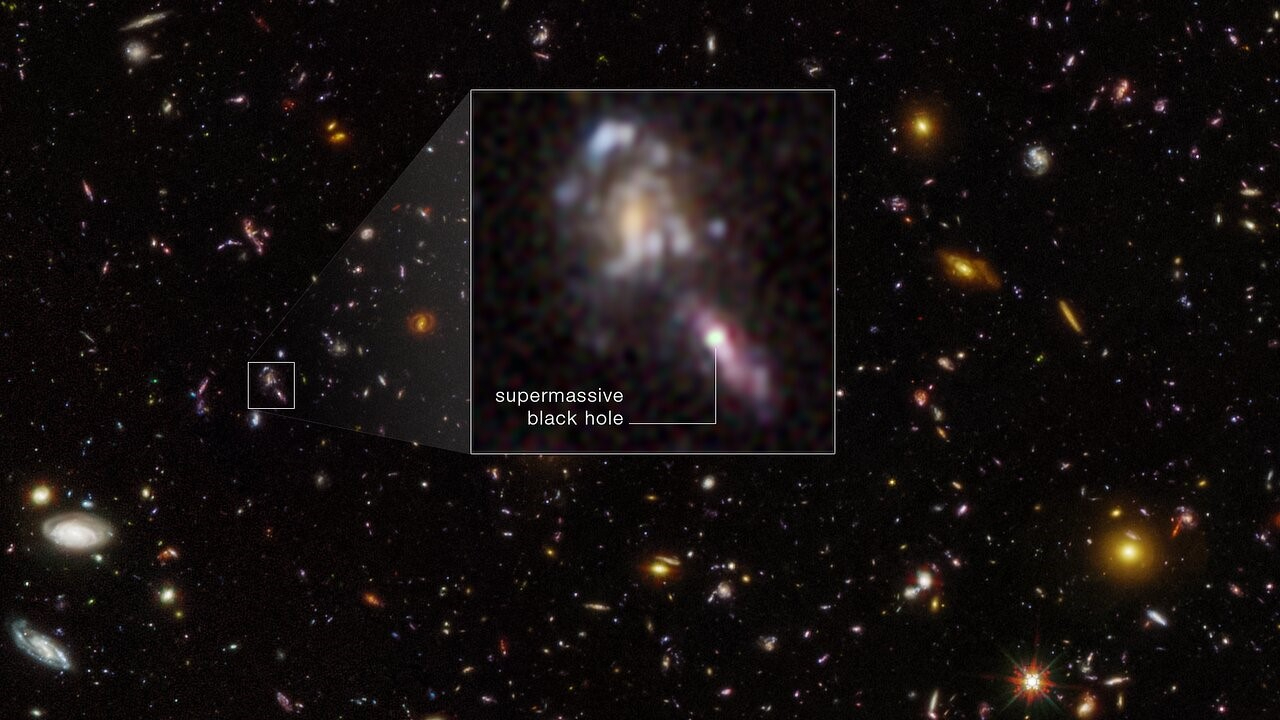
A host of supermassive black holes populating the universe during the cosmic dark ages appears to drastically exceed estimates for how many billion-solar-mass black holes should have existed back then. The surprising find is the result of a 14-year study conducted with the Hubble Space Telescope.
The study team, led by Matthew Hayes of Stockholm University, searched for these early supermassive black holes by scouring the Hubble Ultra Deep Field for any faint objects that seem to exhibit variable brightness.
The Hubble Ultra Deep Field offers an extremely deep look into a tiny patch of the night sky — 3.1 square arcminutes, to be precise. It contains about 10,000 galaxies from all different epochs of cosmic history, with the faintest existing when the universe was less than 500 million years old.
Hayes' group studied a small sample of the Hubble Ultra Deep Field, looking for anything that might have changed brightness over time. The reasoning behind this criteria is that supermassive black holes should have grown very quickly to become so massive in less than a billion years after the Big Bang — and to grow so rapidly, they should have been feeding rapidly on the matter that forms intensely hot and luminous accretion disks around black hole. Astronomers more specifically call these objects AGN, or active galactic nuclei, and they can significantly outshine the rest of their host galaxy.
However, the infall rate of matter onto an AGN is not constant. Like a river, the flow can sometimes surge, and other times drop to a trickle. In turn, this can affect the brightness of an AGN. So, Hayes' team searched the Hubble Ultra Deep Field for anything that changed brightness because that variation could indicate an AGN.
In their small search area, the researchers found 71 variable sources. Many of these are seen as they were when the universe was only several billion years old. Some of the selected subjects are associated with supernova explosions in a galaxy in the field of view, but three of the sources indeed appear to be AGN that existed over 12.7 billion years ago, when the cosmos was less than a billion years old.
Given how small the observed patch of the night sky was, finding three AGN powerful enough to mark billion-solar-mass black holes in such an early epoch of time greatly exceeds expectations (for comparison, the supermassive black hole in our galaxy, Sagittarius A*, is only 4.1 million solar masses, and it has had over 13 billion years to grow to its size). Extrapolating across the entire sky also means reaching the conclusion that such enormous black holes must have been plentiful in this ancient epoch of the universe. And their enhanced numbers may provide strong clues about how they formed.
"Many of these objects seem to be more massive than we originally thought they could be at such early times — either they formed very massive or they grew extremely quickly," said Stockholm' University's Alice Young, who is a member of Hayes' team, in a statement.

One of the faraway AGN, labeled 105212, brightened by 0.3 magnitudes between 2009 and 2012, but by 2023 it had faded by 0.17 magnitudes. It's measured to be at a redshift of 6.7, meaning that we see it as it existed around 12.8 billion years ago. Another AGN, designated 101159, is at a similar redshift of 6.5 and was visible in 2009 but had faded out of sight during the years 2012 and 2023. We know it is real though, because the James Webb Space Telescope (JWST) has since imaged the host galaxy that this AGN resides in. The third high-redshift AGN is 1052156, which is at redshift 6.2 and was seen to change brightness by 0.2 magnitudes between 2009 and 2012, and had faded out of sight by 2023.
There are many hypotheses about how supermassive black holes came to be in the early universe. Were they born in the immediate aftermath of the Big Bang from microscopic primordial seed black holes that have been growing ever since? Or did they get a kickstart in their growth by forming through the direct collapse of an immense gas cloud thousands of times more massive than our sun?
The number density of billion-solar-mass black holes in the early universe that Hayes' team uncovered actually best fits simulations that depict supermassive black holes growing from the collapse of the very first, extremely massive stars. These stars formed in huge "mini-haloes" of matter and dark matter in the cosmos and had masses thousands of times greater than our sun.
Rather than exploding as supernovas, however, these primordial stars quickly collapsed in on themselves from their own gravitational pulls, forming what are called intermediate mass black holes (more massive than the typical stellar mass black holes produced by supernova explosions today, yet less massive than the supermassive behemoths). These first stars formed perhaps between 150 million and 200 million years after the Big Bang, and quickly began consuming matter and growing.
The next generation of stars that formed would have been unable to form black holes of such huge masses, because their birth zones were irradiated by ultraviolet light from other nearby stars and buffeted by the shockwaves of nearby supernovas, which would have altered the conditions for star formation. The next generation of stars were more "normal" stars with masses typical of what we find in our galaxy today.
'"The formation mechanism of early black holes is an important part of the puzzle of galaxy evolution," said Hayes. "Together with models for how black holes grow, galaxy evolution calculations can now be placed on a more physically motivated footing, with an accurate scheme for how black holes came into existence from collapsing massive stars."
If correctly interpreted, the findings could therefore not just teach us about supermassive black holes, but also about the very first stars to exist. The next step is to probe even more carefully and more deeply into the universe with the JWST. However, having only launched in December of 2021, the JWST has not yet had a chance to build up observations over a long enough time frame to detect the variability of AGN in the early universe. The JWST imaged the Hubble Ultra Deep Field on its own for the first time in 2023 —- but, as Hayes' team writes in its research paper, the Hubble Space Telescope has provided a head start.
The findings were published on Aug. 6 in The Astrophysical Journal Letters.







